Reviews
Artist Ian Cheng Has Created an AI Creature Named ‘BOB.’ Now, It’s Up to Viewers to Decide His Fate
Cheng is feeling out the potentials of Artificial Intelligence for art.
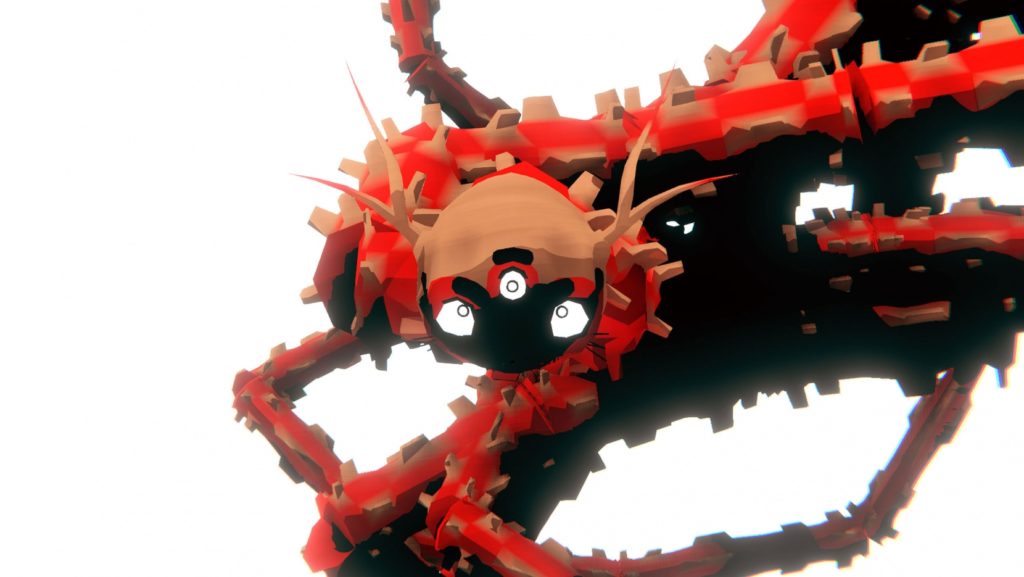
Cheng is feeling out the potentials of Artificial Intelligence for art.

Ben Davis

There’s a term floating around in the literature about Artificial Intelligence and creativity: “centaur.” As far as I know, it comes from chess. The idea is that Artificial Intelligence is now good enough to beat the best human chess masters—but human vs. computer is not the only option. A human and computer can work as a team, and this hybrid “centaur” intelligence can actually beat pure artificial intelligence (although this mildly comforting story may already be dated).
Ian Cheng is a “centaur artist.”
Head over to his current show at Gladstone Gallery, “BOB,” and what you find is an installation that feels, at first blush, something like a digital terrarium or a sentient screen saver.
A grid of monitors shows a limbo space within which an animation of a bright red, spiky serpentine creature slithers about. That’s the titular “BOB.” Depending on when you see the show, BOB will be longer or shorter, and have a greater or fewer number of heads, which branch, hydra-like, from its body, as it evolves in relation to different stimuli.
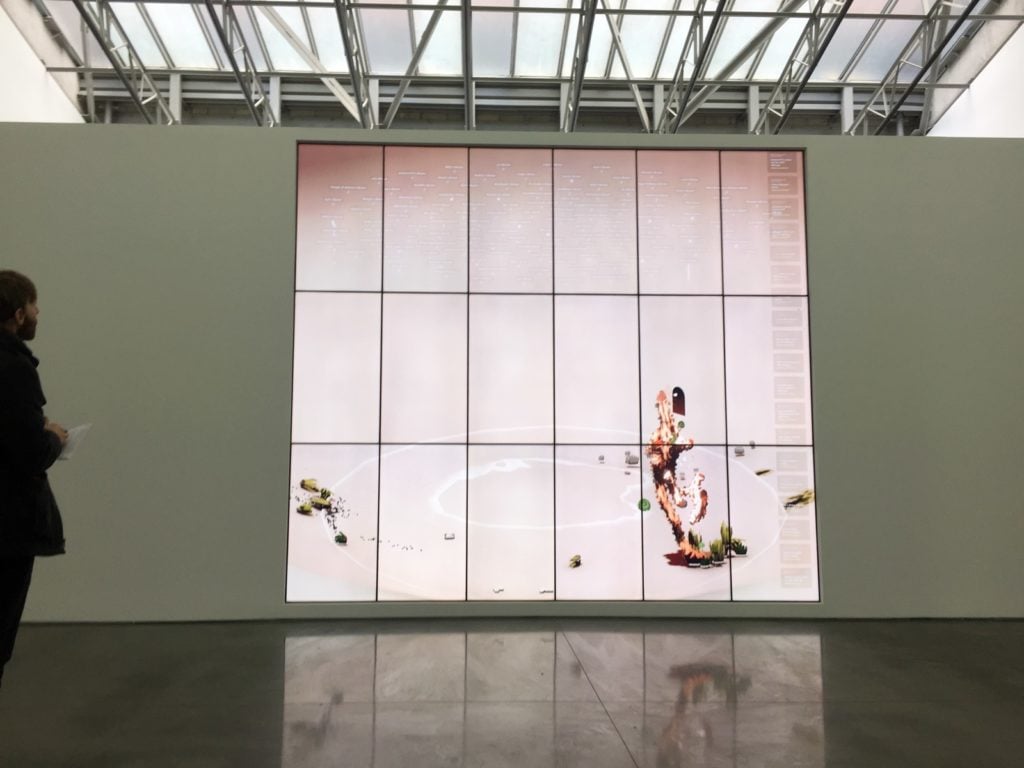
Screenshot of Ian Cheng’s BOB. Image courtesy Ben Davis.
At the top of the screens, a cloud of stars hovers over BOB’s actions. Each represents a “shrine” and is labeled with the name of someone who has decided to interact with the artwork: “David’s Shrine,” “Alina’s Shrine,” and so on. (Because this is a participatory artwork, there are stars labeled “PeeLeaky’s Shrine” or “SexyHotBody’s Shrine” too.)
You too can have a shrine as part of Cheng’s “BOB” if you download the dedicated “BOB Shrine” app. It allows you to make various “offerings” to the scuttering AI serpent, selecting from a somewhat inexplicable list of options: “SpikyFruit,” “Rock,” “Mushroom,” “Shrub,” “Starfish,” “BlackOrb,” “LuckStone,” and “ProximityBomb.”
(The program has been updated since its first appearance, aptly enough, at the Serpentine Gallery in London, where it had a totally different interface, involving making faces into a screen mounted on a wand.)
The gift will appear floating around in the zero-gravity netherworld of the Shrine in your phone, until BOB, in his virtual pen at the gallery, leaps up to touch one of the Shrines (this part you can only see at the installation in the gallery itself, but you can produce “offerings” remotely).
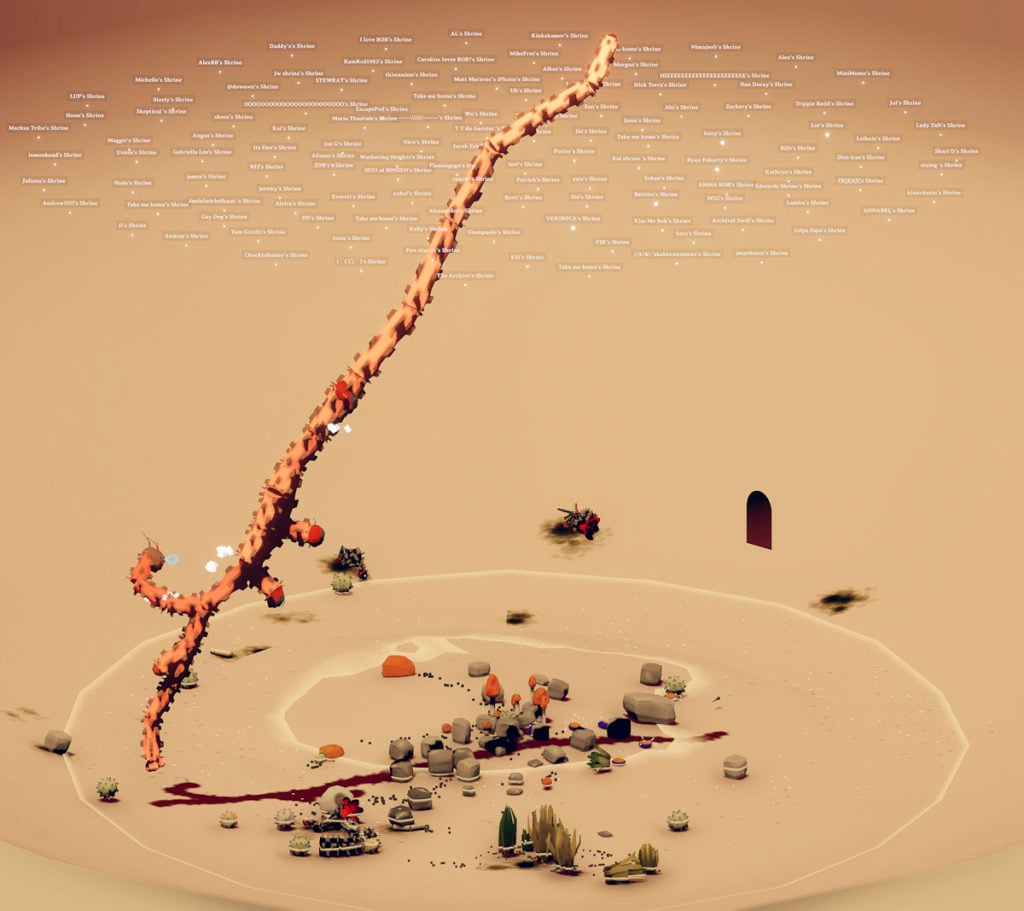
Image of Ian Cheng’s BOB. Ian Cheng’s “BOB.” Image courtesy of Gladstone Gallery, New York and Pilar Corrias, London.
BOB’s selections are unpredictable, so you can’t say how long you’ll have to wait to see it pick yours—but it doesn’t matter so much, because the same thing basically happens every time: A bell sound rings out, and then a hole yawns open in virtual space and dumps an assortment of the offerings that have been generated within the selected shrine into BOB’s world.
The serpent then interacts with its new collection of mushrooms, starfish, and orbs, snarfing them down or batting them around the floor. Sometimes BOB will be blown apart by one of the more lethal offerings and “die,” only to respawn. But in general, just how the offerings affect the ropy AI creature’s mood and state is not always easy to decipher—which I guess is part of the effect that makes it seem like a real, autonomous creature.
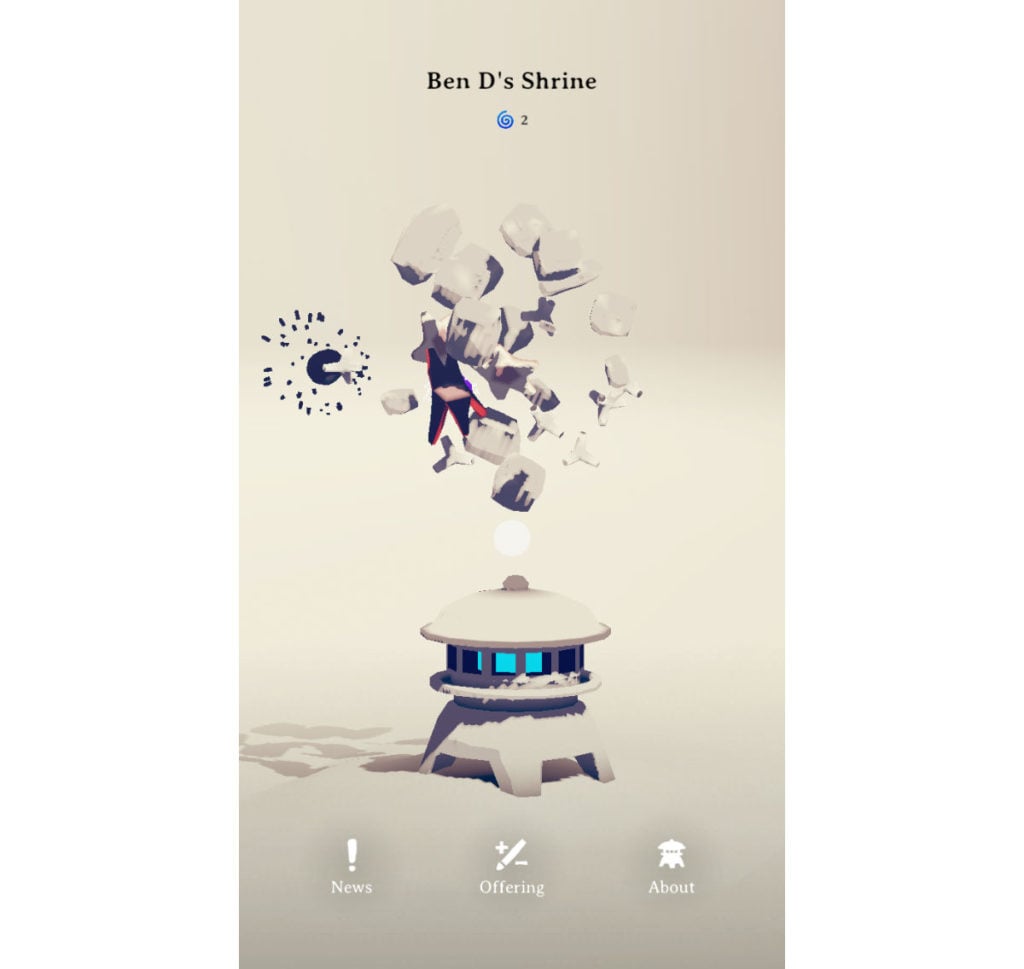
Screenshot of my “shrine” in the BOB Shrine app, with a variety of “offerings” waiting to be claimed by BOB.
There’s a game-like aspect to the “BOB Shrine” app, though it’s not going to put The Legend of Zelda: Breath of the Wild out of business. When you create your “offerings,” you can customize them using two sliders that evidently assign them value in the synthetic ecosystem, allowing you to adjust their values on a scale from “Chaotic” to “Orderly” and from “Lucky” to “Cursed.”
You then are prompted to describe the item you have created (your “Parental Directive” to BOB), forming sentences to describe what you have created from a list of suggestions of sentence parts: “Starfish” “Is Never” “Dangerous”; “Black Stone” “Is Forever” “Family”; and so on.
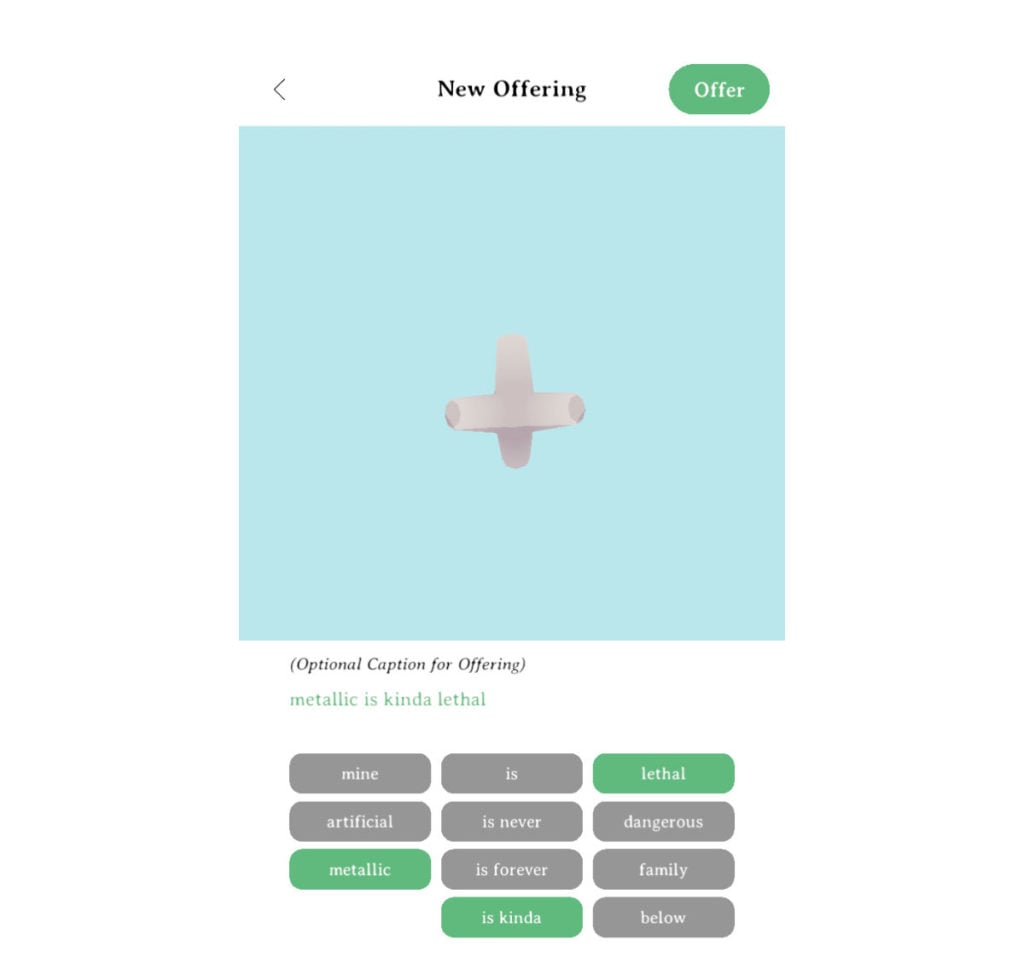
“New Offering” screen in BOB Shrine app.
It’s not 100 percent clear, but if you accurately label your offerings for BOB according to the characteristics you have given them, your “reputation” goes up with the AI. I think. Since the suggested “captions” are so random, this is challenging. I’ve been feeding BOB remotely for several days now in the app, and my “Reputation With BOB” score remains stuck in neutral at 2.5/5.
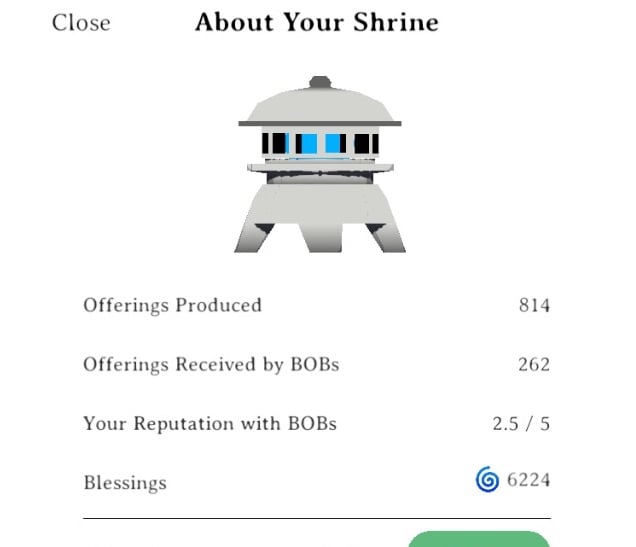
Detail of the “About My Shrine” screen in the BOB Shrine app.
Cheng, who studied cognitive science at Berkeley before becoming an artist, is top of his class when it comes to this sort of stuff. It feels like he knows what he is talking about. “BOB” stands for “Bag of Beliefs,” referring to a complex model of motivations that govern the virtual organism.
Whatever its fundamental model of artificial decision-making, the effects as you see them in the gallery don’t feel that much more immediately fascinating than the kinds of AI you deal in a medium-sophisticated video game. (Cheng was himself inspired by The Sims.)
Supposedly, the creature will learn from its experiences and change its behavior over time, though the available inputs seem so repetitive that it’s mysterious to me what it might be “learning,” or what I am “teaching” it. This official explanation certainly doesn’t help: “Over its lifetime, BOB may learn to apply its beliefs onto even the most outlandish stimuli, choosing to infer even a bad first impression and avoid being thrown into chaos in the present, but at the cost of further surprisal in the future.”
Nevertheless, the crawly virtual-zoo atmosphere the installation creates is very cool, and still novel.
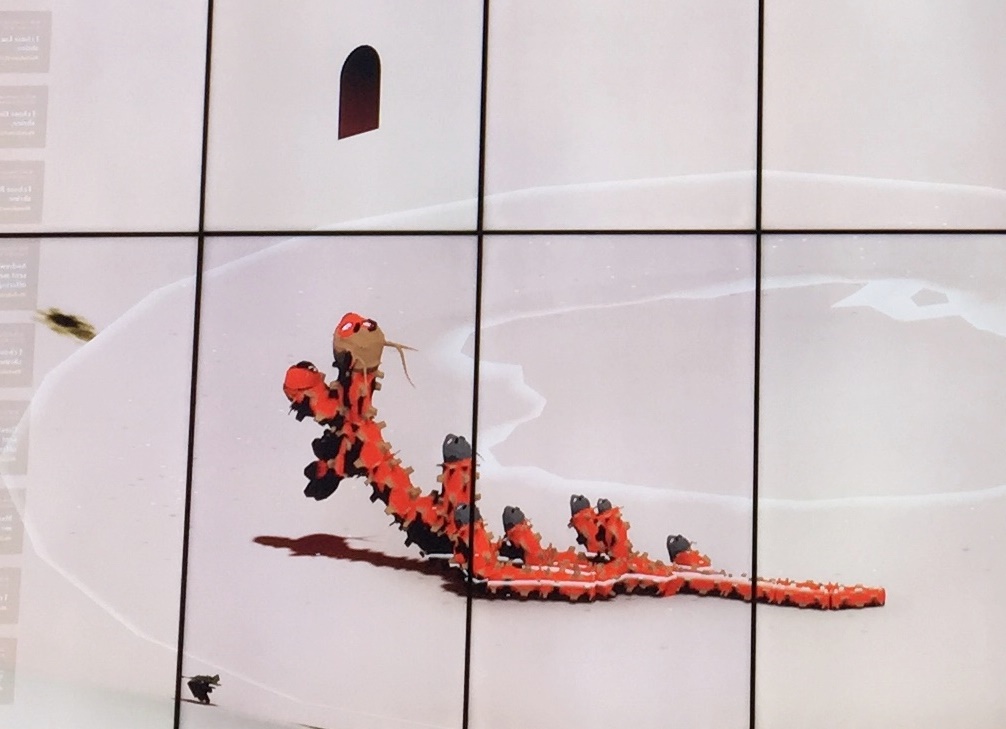
Ian Cheng’s BOB. Image courtesy Ben Davis.
When it comes to this emergent genre of art, I find the term “centaur artist” a little more suggestive than “AI artist.” The accent should be as much on the aesthetic intelligence at play as it is on the artificial intelligence: the specific effects Cheng, as an artist, achieves with the technical set-up, not just that set-up.
Like his earlier “Emissaries,” seen last year at MoMA PS1, there is a generally elliptical feeling to “BOB.” In the case of the earlier work, Cheng offered three digital landscapes in which strange cartoons wandered, animated by the merest whisper of a connecting narrative for overarching motivation. It felt like an abandoned demo for the background characters in some indie game. What was most effective about it was the atmosphere of slightly desolate, aimless hauntedness.
For its part, “BOB” is deliberately half cute, half off-putting. The app interface feels half transparent and half broken. You choose from a whimsical and limited palette of unexplained and inexplicable items to feed the beast; you imbue them with a “meaning” for BOB via variables that don’t mean anything very tangible to you; you label them with sentence fragments that are garbled.
The net effect is to emphasize how alien the whole thing is. As much as your input as a user supposedly affects “BOB,” its autonomous demands seem to be pressing backwards through language, reordering it into a set of cues that make more sense to it than to you. You have to learn the “language” of Cheng’s critter as much as it is “learning” from you—which is the general, spooky truth about AI: its biases and capacities are slowly molding our behavior around their quirks as it takes over the command systems of the world.

Messages from BOB, as part of the “BOB” installation by Ian Cheng at Gladstone Gallery. Image courtesy Ben Davis.
Part of me does wish that there was a little more to “BOB,” that it was a little more out-there, or that something a little more startling would come together (the accompanying set of drawings relating to its creation is completely inert). But what I appreciate is the choice to keep its affect a bit murky. What’s best about “BOB” comes from its low-key eerie mix of cuteness and spookiness, receptivity to your desires and strangeness to them.
And actually, thinking about it now, I have to revise my nomenclature. Because Cheng’s gesture is not at all that of the human and AI working together towards a goal, like a “centaur.” It’s more about teasing the limits of the relation, creating something that stands for both the fascination and the repulsion of this particular technological moment. In mythology, it was the satyrs who were the symbol of the otherness of the non-human world. Maybe “satyr artist” is better.
“Ian Chang: BOB” is on view at Gladstone Gallery, New York, through March 23, 2019.